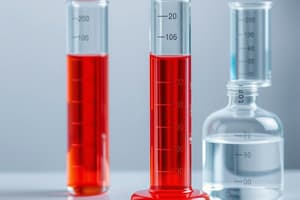Podcast
Questions and Answers
Flashcards
Endothermic solution formation
Endothermic solution formation
A process where the enthalpy change is positive (heat is absorbed) but can still occur if the entropy change is large and positive, favoring the formation of a solution.
Osmotic pressure
Osmotic pressure
The force that drives the movement of solvent across a semipermeable membrane from a region of high solvent/low solute concentration to a region of low solvent/high solute concentration.
Saturated solution
Saturated solution
A solution that contains the maximum amount of solute that can dissolve at a given temperature.
Unsaturated solution
Unsaturated solution
Signup and view all the flashcards
Colligative property
Colligative property
Signup and view all the flashcards
Supersaturated solution
Supersaturated solution
Signup and view all the flashcards
Boiling point
Boiling point
Signup and view all the flashcards
Vapor pressure
Vapor pressure
Signup and view all the flashcards
Freezing point
Freezing point
Signup and view all the flashcards
Osmosis
Osmosis
Signup and view all the flashcards
Solution
Solution
Signup and view all the flashcards
Concentration
Concentration
Signup and view all the flashcards
Solvent-solvent interactions
Solvent-solvent interactions
Signup and view all the flashcards
Solute-solvent interactions
Solute-solvent interactions
Signup and view all the flashcards
Solubility
Solubility
Signup and view all the flashcards
London dispersion forces
London dispersion forces
Signup and view all the flashcards
Dipole-dipole interactions
Dipole-dipole interactions
Signup and view all the flashcards
Hydrogen bonding
Hydrogen bonding
Signup and view all the flashcards
Ion-dipole interactions
Ion-dipole interactions
Signup and view all the flashcards
Ionic forces
Ionic forces
Signup and view all the flashcards
Breaking solute-solute interactions
Breaking solute-solute interactions
Signup and view all the flashcards
Breaking solvent-solvent interactions
Breaking solvent-solvent interactions
Signup and view all the flashcards
Forming solute-solvent interactions
Forming solute-solvent interactions
Signup and view all the flashcards
Entropy change
Entropy change
Signup and view all the flashcards
Enthalpy change
Enthalpy change
Signup and view all the flashcards
Like dissolves like principle
Like dissolves like principle
Signup and view all the flashcards
Dynamic equilibrium
Dynamic equilibrium
Signup and view all the flashcards
Solubility product constant (Ksp)
Solubility product constant (Ksp)
Signup and view all the flashcards
Common ion effect
Common ion effect
Signup and view all the flashcards
Ion
Ion
Signup and view all the flashcards
Electrolyte
Electrolyte
Signup and view all the flashcards
Nonelectrolyte
Nonelectrolyte
Signup and view all the flashcards
Weak electrolyte
Weak electrolyte
Signup and view all the flashcards
Strong electrolyte
Strong electrolyte
Signup and view all the flashcards
Van't Hoff factor (i)
Van't Hoff factor (i)
Signup and view all the flashcards
Colloidal solution
Colloidal solution
Signup and view all the flashcards
Tyndall effect
Tyndall effect
Signup and view all the flashcards
Hydrophilic colloid
Hydrophilic colloid
Signup and view all the flashcards
Hydrophobic colloid
Hydrophobic colloid
Signup and view all the flashcards
Surfactant (emulsifier)
Surfactant (emulsifier)
Signup and view all the flashcards
Emulsion
Emulsion
Signup and view all the flashcards
Emulsification
Emulsification
Signup and view all the flashcards
Study Notes
Solution Formation
- Favorable solution formation: Exothermic enthalpy change and increasing entropy are always favorable for solution formation.
Solution Formation Processes
- Exothermic process: Forming solute-solvent interactions is always exothermic.
Solution Formation Conditions
- Positive enthalpy change: If a solution formation process has a positive enthalpy change, it can still occur if the entropy change is large and positive.
Solute Solubility
- Primary factor: Intermolecular forces are the primary factor in determining whether a solute dissolves in a solvent.
- "Like dissolves like": Solvents with similar intermolecular forces (polar or nonpolar) are more effective at dissolving respective solutes.
Intermolecular Forces in Nonpolar Substances
- London dispersion forces: The dominant intermolecular force in nonpolar substances is London dispersion forces.
Oil and Water Miscibility
- Immiscibility: Oil does not dissolve in water because oil molecules are nonpolar and water molecules are polar, making them incompatible.
Dynamic Equilibrium in Solutions
- Dissolution and crystallization: Dynamic equilibrium in solutions maintains a balance between dissolution and crystallization, keeping the rate of both processes the same.
- Solubility constant: The equilibrium expression for an ionic solid dissolving in water is represented by Ksp = [cation]^m [anion]^n.
- High Ksp value: A high Ksp value indicates high solubility of a substance.
Pressure and Solubility
- Gas solubility: Increasing pressure increases the solubility of gases in liquids.
Temperature and Solubility
- Solid solubility: Increasing temperature often increases the solubility of solids in liquids.
- Gas solubility: Increasing temperature decreases the solubility of gases in liquids.
Common Ion Effect
- Solubility decrease: Adding a common ion to a saturated solution decreases the solubility of the solute.
Colligative Properties
- Freezing point depression: Increasing the number of solute particles in a solvent lowers the freezing point.
- Boiling point elevation: Increasing the number of solute particles in a solvent raises the boiling point.
- Osmotic pressure: Increasing the solute concentration increases osmotic pressure.
- Vapor pressure lowering: Adding a non-volatile solute to a solvent lowers the vapor pressure.
Colligative Properties and Factors
- Solute particles: The number of solute particles significantly affects colligative properties.
- Temperature: Changes in temperature affect some colligative properties but not others.
- Solubility of Ionic Compounds: Factors like common ion effect and solvent polarity affect the solubility of ionic compounds.
Types of Solutions
- Saturated solution: Contains the maximum amount of a solute at a given temperature and pressure.
- Supersaturated solution: Contains more solute than a saturated solution.
Colloids
- Tyndall effect: Colloids scatter light, thus exhibiting the Tyndall effect.
- Particle size: Colloid particles are larger than solution particles but smaller than suspension particles.
Hydrophilic Colloids
- Stability: Hydrophilic colloids remain stable due to hydration shells and electrostatic repulsion.
- Stability of hydrophobic colloids: Hydrophobic colloids' stability requires emulsifiers (stabilization due to surface charges).
Studying That Suits You
Use AI to generate personalized quizzes and flashcards to suit your learning preferences.
Related Documents
Description
Explore the key concepts of solution formation, including the importance of enthalpy and entropy changes. Understand the role of intermolecular forces in solute solubility and the principle of 'like dissolves like'. This quiz covers essential topics for chemistry students studying solutions.




